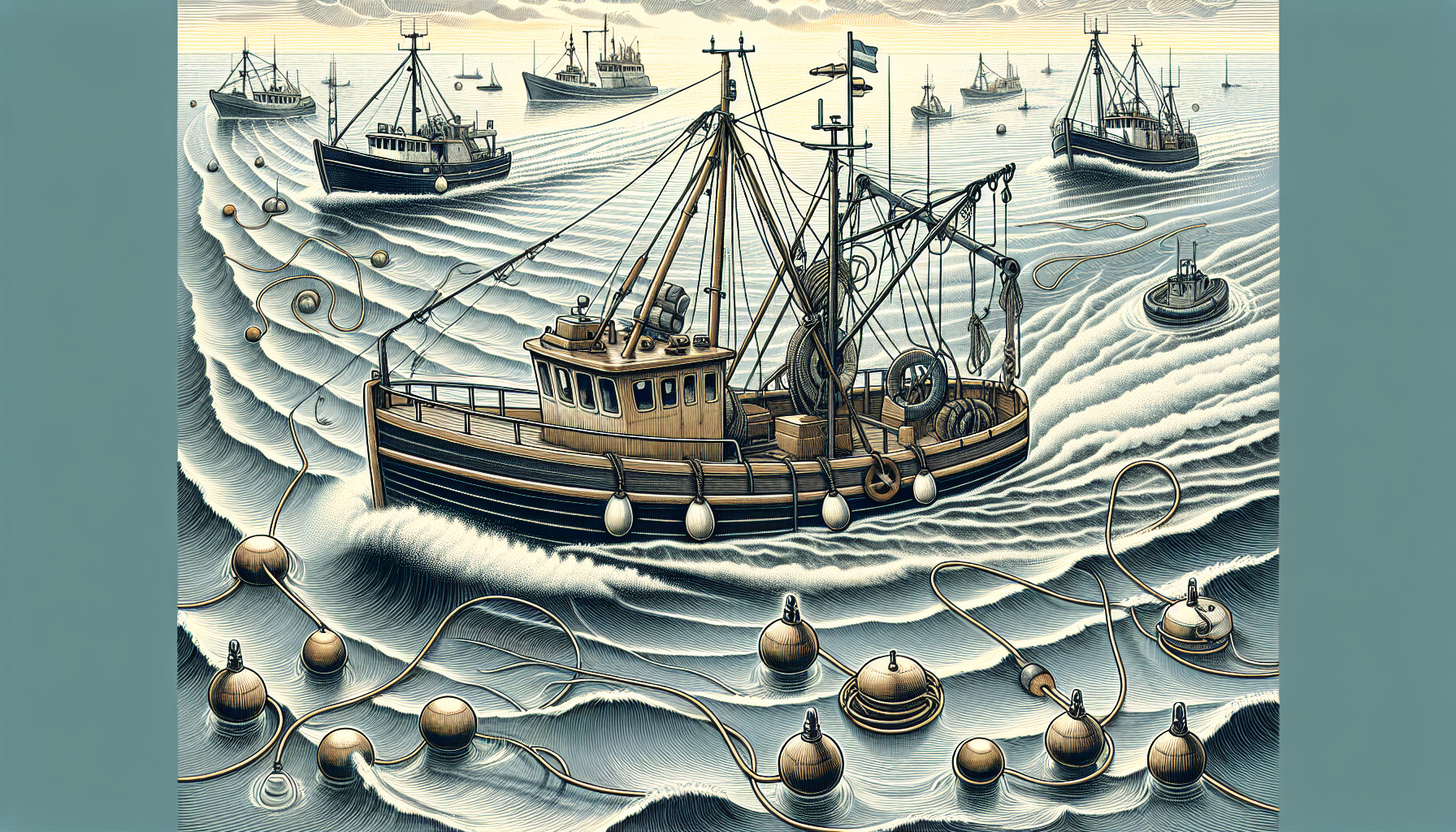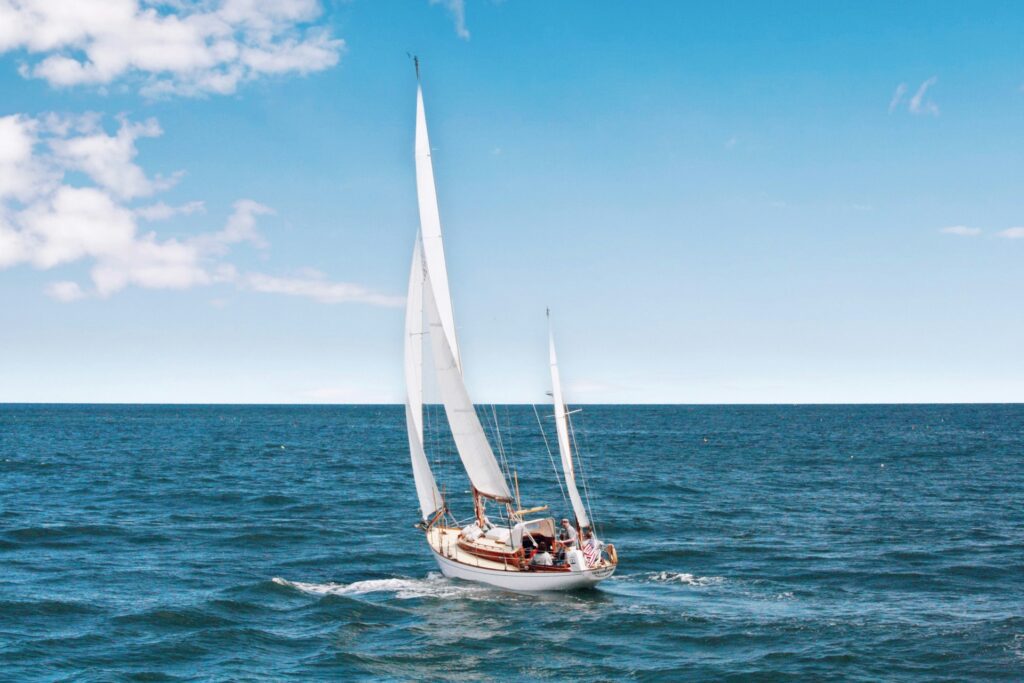Are you wondering how should you pass a fishing boat while adhering to maritime safety regulations? This no-nonsense guide dives straight into the right-of-way rules, essential communication signals, and how to assess the situation to make a safe pass. Get ready to navigate these waters with confidence by understanding the key steps to take when you encounter a fishing boat.
Key Takeaways
- Practicing safe passing techniques is essential for preventing collisions and observing maritime right-of-way rules, particularly when navigating crowded waterways and around fishing boats with potentially dangerous equipment.
- Maritime navigation protocols prioritize vessels based on their activity, with fishing boats actively engaged in fishing given a higher priority due to their limited maneuverability, necessitating power-driven and sailing vessels to act as ‘give-way’ crafts.
- Safely passing a fishing boat involves assessing the conditions, clear communication with proper signaling, choosing the correct side for the pass, maintaining safety distance, and exercising patience and caution; US Coast Guard guidelines and Vessel Safety Checks ensure vessels comply with safety standards.
The Importance of Safe Passing Techniques

Practicing safe passing techniques is essential to avoid collisions and damages due to lines and ropes from fishing boats in the water. It’s not just about safety, but also about respecting the rights and practices of other watercraft users. By operating the boat safely and respectfully, with awareness of both conditions and other boaters, we ensure a fundamental precaution is observed on the water.
Learning and adhering to safe passing techniques are crucial for overall safety on the water. It’s like learning to drive on the road. You wouldn’t just speed past another vehicle without checking your rearview mirror, would you? Similarly, understanding the dynamics and nuances of passing a fishing boat is crucial to maintain safety.
Crowded Waterways
Navigating through crowded waterways is akin to maneuvering through peak hour traffic. The heightened awareness required is critical due to the increased risk of collisions and accidents. With greater boat traffic, incidents can occur more frequently and may be more severe, necessitating extra caution.
As a responsible boater, one must be vigilant in monitoring their surroundings as more vessels in close proximity can lead to complex navigational situations. It’s like a ballet on water, where each vessel has a part to play, and one wrong move can disrupt the rhythm. So, improving situational awareness is critical to respond to the sudden movements of other vessels and avoid accidents.
Fishing Boat Equipment
Fishing boats are often laden with high tension lines, cables, hydraulic haulers, and winches, all of which can lead to contact injuries, including amputations and fatalities. In fact, the leading cause of fatalities onboard fishing vessels is contact with gear, equipment, and machinery, accounting for 40% of such incidents.
To mitigate these dangers, it is vital to maintain a safe distance from fishing boats and avoid hazards like entanglements. Implementing safety measures such as installing emergency-stop buttons, eliminating slip and trip hazards, and developing safe work practices are crucial steps in this regard. Remember, when you’re on the water, safety should always be your anchor.
Understanding Right-of-Way Rules
In maritime navigation, priority or right-of-way is determined by a ‘pecking order’, where vessels lower in rank must give way to those higher up. Much like how emergency vehicles have the right-of-way on roads, fishing boats with gear in the water are granted higher priority due to their limited maneuverability.
Power-driven vessels are required to keep out of the way of fishing vessels that are actively engaged in fishing. Sailboats under sail are given right-of-way over powerboats unless they are overtaking an other boat, such as another vessel. It’s like a dance, where everyone knows their steps and follows the rhythm to ensure a smooth performance.
Give-Way and Stand-On Vessels
Understanding the roles of ‘give-way’ and ‘stand-on’ vessels is paramount in maritime navigation. The ‘give-way’ vessel is the one that does not have the right of way in a passing situation and must adjust its course to avoid interfering with the vessel that has right of way. They must take clear and noticeable action to steer clear of a potential collision with the ‘stand-on’ vessel.
On the other hand, the ‘stand-on’ vessel retains the right of way and is expected to:
- Continue its course and speed during a passing situation
- Maintain their course and speed, acknowledging the ‘give-way’ vessel’s actions
- Alter course only if necessary to prevent a hazardous situation
It’s like a well-coordinated tango, where each dancer knows their part and moves in harmony with their partner.
Powered Boats vs. Fishing Boats
In the maritime ‘pecking order’, fishing vessels engaged in fishing with gear deployed have priority over both sailing vessels and power-driven vessels. This is because fishing boats have limited maneuverability when their gear is in the water, making it more challenging for them to avoid other vessels.
The established right-of-way rules tend to prioritize commercial fishing or towing vessels, such as fishing trawlers or large tugboats, as opposed to recreational fishing boats. It’s like a game of chess, where each piece has its own movement rules and importance. Knowing these rules can be the key to a safe and enjoyable day on the water.
Steps for Safely Passing a Fishing Boat
Passing a fishing boat safely is a process that requires careful assessment of the situation, effective communication, and choosing the correct side for passing. Start by assessing the situation around the fishing boat, including weather conditions, boat traffic, and the position of the fishing vessel before attempting to pass. It’s like mapping out your route before embarking on a journey.
To safely pass a fishing boat, follow these steps:
- Follow established communication and signaling protocols to convey your intentions to the fishing boat before passing.
- Choose the correct side for passing the fishing boat, typically the starboard side, unless the situation dictates otherwise.
- It’s a three-step dance, where each step is vital to maintaining safety while passing a fishing boat.
Assess the Situation
Before making any passing maneuvers, it is crucial to assess the situation. Here are some factors to consider:
- Weather conditions
- Traffic density
- Water depth
- Visibility
Evaluate these factors to determine the safety of attempting to pass a fishing boat. It’s like crossing a busy street; you wouldn’t just dart across without checking both ways, would you?
Before passing, it is crucial to:
- Observe if the fishing boat has lines or ropes deployed in the water
- Identify any nearby obstacles or hazards
- Consider the weather conditions, boat traffic, and the position of the fishing vessel before executing a passing maneuver
Remember, safety first!
Communication and Signaling
Communication and signaling are key during passing maneuvers. Sound signals, such as short and prolonged blasts from a horn, are key communication methods used to indicate intentions when passing. It’s the maritime equivalent of using turn signals on a road.
Besides sound signals, additional recommended methods for communicating passing intentions include flags, hand gestures, and verbal communication. The customary signal for the intention to pass on the starboard side is one horn blast and two for the port side, with a responding single or double blast from the other vessel to indicate agreement and the all-clear to proceed. It’s like a secret language, understood and respected by all who sail the seas.
Choosing the Correct Side
Choosing the correct side to pass a fishing boat is another crucial step. Generally, passing should be done on the starboard side, ensuring predictable and manageable passing for all boaters. In a channel or harbor, it is required to steer to the starboard side when passing another boat.
Port-side passing is preferred when starboard passing is not viable, such as scenarios when a fishing boat’s lines are cast toward shore. Clear communication is essential when passing on the port side is necessary. In a head-on situation between two power-driven vessels, both should alter their course to starboard in order to pass port-to-port. Remember, when in doubt, always communicate and maintain safety on both port sides.
Tips for Maintaining Safety During Passing

Maintaining safety during passing is a collective responsibility of all boaters. It starts with minimizing wake when passing a fishing boat to prevent causing instability or swamping the vessel. Reducing speed is essential to minimizing wake, especially when passing close to fishing boats. It’s like lowering your voice in a library; you do it to respect others and maintain a peaceful environment.
Keeping a safe distance from fishing boats ensures that your boat will not get entangled in fishing lines or nets. A safe distance also prevents interference with the fishing boat’s operation and reduces the risk of collisions. Approach passing maneuvers with patience and caution, taking into consideration the movement and speed of the fishing boat. Remember, patience is not just a virtue; it’s a necessity on the water.
Minimizing Wake
Minimizing wake is one way to ensure safety during passing. Boaters should go slowly when passing a fishing boat to avoid creating dangerous wakes that could rock the fishing vessel and endanger its occupants. As the speed of a boat increases, so does the number and extent of wakes produced, emphasizing the need for speed regulation to achieve minimum wake and minimize these effects.
Wakes from displacement hull boats create a consistent 19.5-degree angle from each side of the hull, impacting the distance over which the wake can affect other boats. The US Coast Guard Navigation Rules suggest that alterations of a vessel’s speed or course during passing should be significant and made early enough to provide adequate sea room for safe passage. It’s like slowing down before a curve on the road; you do it to maintain control and ensure safety.
Safe Distance
Maintaining a safe distance from fishing boats is another crucial tip for safe passing. Entanglement in fishing gear, such as nets and lines, poses a significant risk, potentially causing damage or injury to vessels passing by. A minimum distance of 100 feet should be maintained when passing a fishing boat; if it is necessary to pass at a closer range, slowing down and proceeding with caution is vital.
It’s like maintaining a safe following distance on the road; it gives you room to maneuver and react.
Patience and Caution
Patience and caution are virtues that every boater should possess. Exercising patience is critical during the maneuvers of passing fishing boats to prevent any accidents and ensure the safety of all vessels involved. Attempting to pass fishing boats quickly or aggressively due to impatience can lead to dangerous situations.
Patience in navigating waters ensures that skippers do not make rushed decisions that might compromise safety. It’s like waiting for your turn at a four-way intersection; you wait not just because it’s the rule, but because it’s the safe and respectful thing to do.
US Coast Guard Guidelines
The US Coast Guard and its Auxiliary conduct Vessel Safety Checks (VSC) to ensure boats are in compliance with federal and state boating laws. Boats passing the VSC are awarded a U.S. Coast Guard Auxiliary Decal, which indicates their compliance with boating laws to law enforcement and safety agencies. If a boat does not pass the VSC, no citation is issued; instead, owners receive a report detailing necessary corrections to meet safety standards.
A VSC provides boat owners with the assurance that their vessel meets federal safety standards and possesses the required emergency equipment, helping them avoid potential fines for violations. It’s like a yearly health check-up for your boat, ensuring it’s in top-notch condition for your maritime adventures.
Regulations and Requirements
The Navigation Rules of the Road govern vessel interactions, emphasizing responsible navigation rather than granting absolute ‘Right-of-Way’, which ensures safe passing based on the type of vessel and its activity. US Coast Guard safety regulations require a Vessel Safety Check (VSC) for various equipment including:
- life jackets
- registration
- navigation lights
- ventilation
- fire extinguishers
- distress signals
- the battery’s cover and connections.
Furthermore, boating insurance providers may offer premium discounts to boat owners who undertake Vessel Safety Checks annually, encouraging adherence to safety regulations. It’s a win-win situation, promoting safety while saving you some bucks!
Resources for Boaters
The US Coast Guard Auxiliary offers a free vessel safety check service to help boaters ensure their watercraft meets necessary safety standards. Vessel safety checks can be conveniently performed at various locations, such as marinas and private driveways, and typically take between 15 to 30 minutes. Boaters should continuously maintain their vessel and its equipment to the standards verified during the safety check, ensuring ongoing compliance and safety on the water.
For further education on boating safety, boaters can access the Boating Safety Resource Center, which provides listings of boating safety courses available nationwide, including online options. It’s like having a personal tutor, guiding you through the intricacies of boating safety at your convenience.
Summary
In conclusion, passing a fishing boat safely is not just a matter of courtesy but a critical aspect of maritime safety. By understanding the importance of safe passing techniques, adhering to the right-of-way rules, and maintaining safety during passing, we can ensure a harmonious experience on the water. The US Coast Guard, with its regulations and resources, provides an invaluable support system for boaters. Remember, when we sail the seas, safety should always be our compass.
Frequently Asked Questions
What should you do to avoid colliding with another boat?
To avoid colliding with another boat, make sure to follow a collision avoidance checklist, including staying alert and being visible, especially at night. Additionally, use up-to-date navigation charts and be aware of whistle signals for danger.
Why should boaters slow down while passing recreational fishing boats?
Boaters should slow down while passing recreational fishing boats to prevent creating a wake that could rock the fishing boat and cause people to fall, potentially leading to injuries or even falling overboard.
What should you do when you encounter a fishing boat?
When encountering a fishing boat, steer your vessel to the starboard side of the boat, passing each other on the port sides and giving them a wide berth to avoid running over their fishing lines. Be courteous and aware of their presence.
What is the correct way to pass a boat?
When passing a boat, always remember to pass port to port, also known as left to left, in accordance with boating rules of the road. This ensures a safe and predictable approach for both vessels.
Should you pass a fishing boat on the upwind side?
No, you should always make an effort to pass on the port side (left) of the fishing boat, according to the US Coast Guard. This ensures that both vessels pass each other on their port sides.

